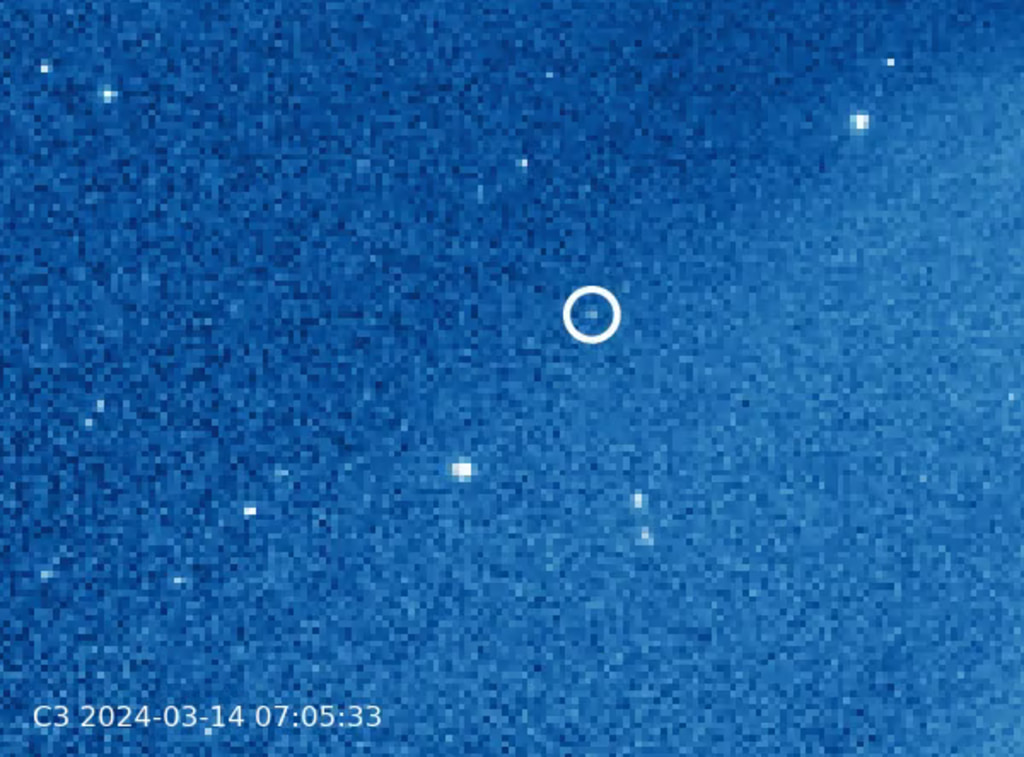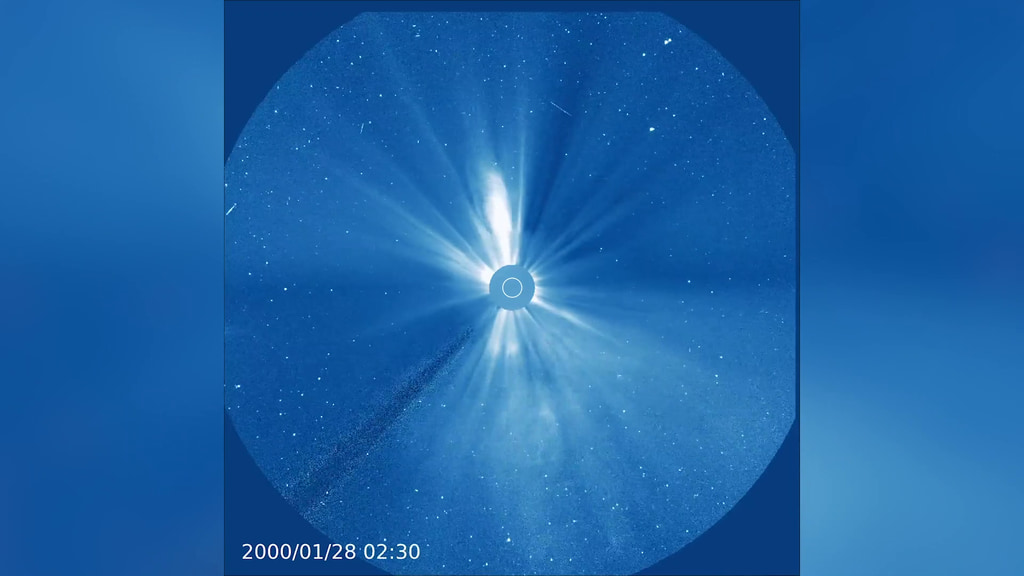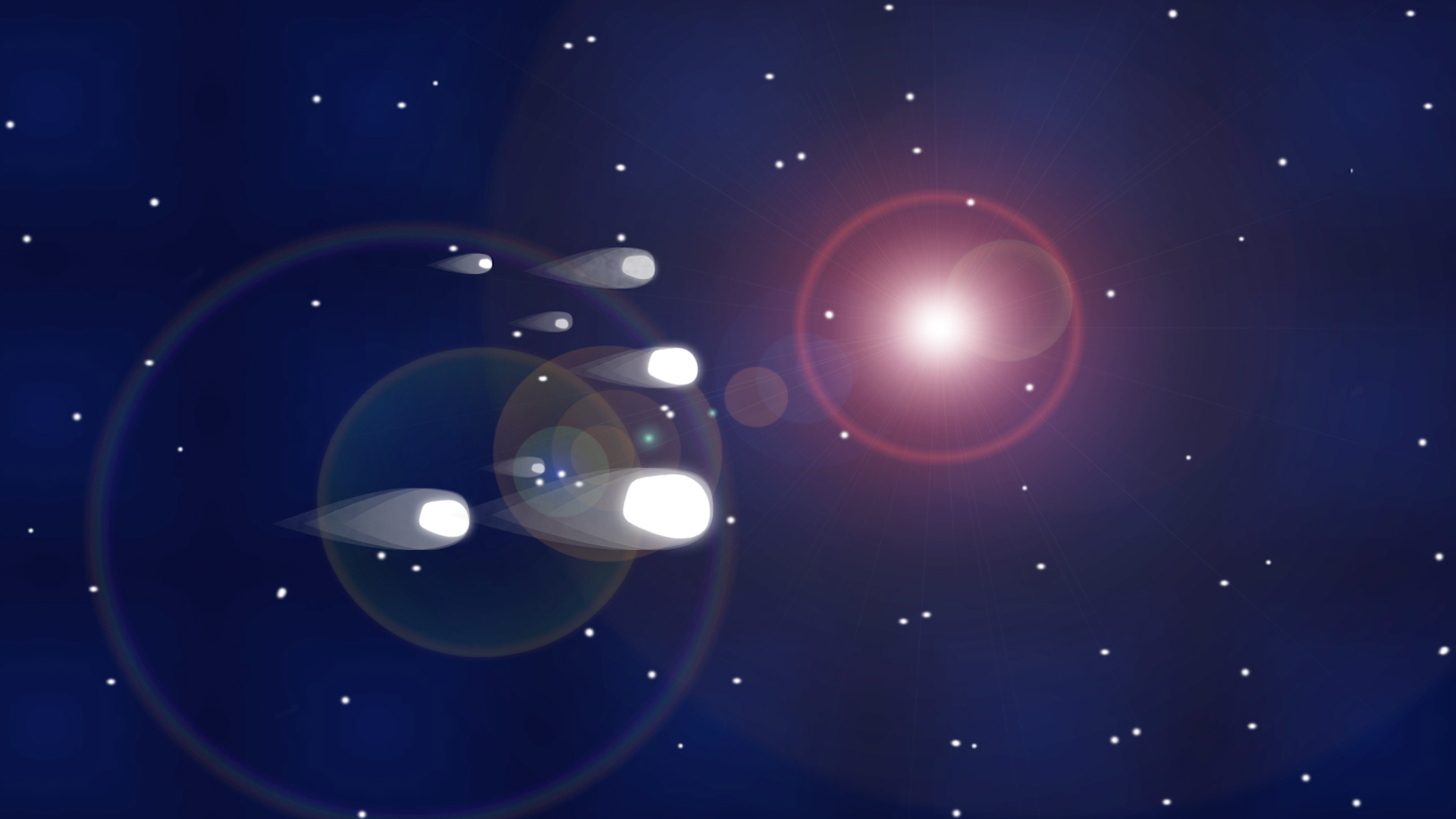Four of Our Favorite SOHO-discovered Comets
Karl Battams, manager of NASA's citizen science Sungrazer Project, talks about his four favorite comets that SOHO has observed.
Music: "Inducing Waves" from Universal Production Music
Watch this video on the NASA Goddard YouTube channel.
Complete transcript available.
On June 15, 2020, a citizen scientist spotted a never-before-seen comet in data from the Solar and Heliospheric Observatory, or SOHO — the 4,000th comet discovery in the spacecraft’s 25-year history.
The comet is nicknamed SOHO-4000, pending its official designation from the Minor Planet Center. Like most other SOHO-discovered comets, SOHO-4000 is part of the Kreutz family of sungrazers. The Kreutz family of comets all follow the same general trajectory, one that carries them skimming through the outer atmosphere of the Sun. SOHO-4000 is on the small side, with a diameter in the range of 15-30 feet, and was extremely faint and close to the Sun when discovered — meaning SOHO is the only observatory that has spotted the comet, as it’s impossible to see from Earth with or without a telescope.
SOHO is a joint mission of the European Space Agency (ESA) and NASA. Launched in 1995, SOHO studies the Sun from its interior to its outer atmosphere, with an uninterrupted view from its vantage point between the Sun and Earth, about a million miles from our planet. But over the past two and half decades, SOHO has also become the greatest comet finder in human history.
SOHO’s comet-hunting prowess comes from a combination of its long lifespan, its sensitive instruments focused on the solar corona, and the tireless work of citizen scientists who scour SOHO’s data for previously-undiscovered comets, which are clumps of frozen gases, rock and dust that orbit the Sun.
The vast majority of comets found in SOHO’s data are from its coronagraph instrument, called LASCO, short for Large Angle and Spectrometric Coronagraph. Like other coronagraphs, LASCO uses a solid object — in this case, a metal disk — to block out the Sun’s bright face, allowing its cameras to focus on the relatively faint outer atmosphere, the corona. The corona is critical to understanding how the Sun’s changes propagate out into the solar system, making LASCO a key part of SOHO’s scientific quest to understand the Sun and its influence.
But focusing on this faint region also means LASCO can do something other telescopes can’t — it can see comets flying extremely close to the Sun, called sungrazers, which are otherwise blotted out by the Sun’s intense light and impossible to see. This is why nearly all of SOHO’s 4,000 comet discoveries have come from LASCO’s data.

The 4000th comet discovered by the European Space Agency & NASA’s SOHO observatory is seen here in an image from the spacecraft alongside SOHO’s 3999th comet discovery.
Credit: ESA/NASA/SOHO/Karl Battams

The 4000th comet discovered by the European Space Agency & NASA’s SOHO observatory is seen here in an image from the spacecraft alongside SOHO’s 3999th comet discovery. Credit: ESA/NASA/SOHO/Karl Battams

The 4000th comet discovered by the European Space Agency & NASA’s SOHO observatory is seen here in an image from the spacecraft alongside SOHO’s 3999th comet discovery. Credit: ESA/NASA/SOHO/Karl Battams

The 4000th comet (top) discovered by the European Space Agency & NASA’s SOHO observatory is seen here in an image from the spacecraft alongside SOHO’s 3999th comet discovery (bottom). Credit: ESA/NASA/SOHO/Karl Battams
This annotated movie from the European Space Agency & NASA’s SOHO observatory shows the 3,999th and 4,000th comets discovered by the spacecraft as they speed towards the Sun.
Credit: ESA/NASA/SOHO/Karl Battams
This annotated movie from the European Space Agency & NASA’s SOHO observatory shows the 3,999th and 4,000th comets discovered by the spacecraft as they speed towards the Sun.
Credit: ESA/NASA/SOHO/Karl Battams
This unannotated movie from the European Space Agency & NASA’s SOHO observatory shows the 3,999th and 4,000th comets discovered by the spacecraft as they speed towards the Sun.
Credit: ESA/NASA/SOHO/Karl Battams
This unannotated movie from the European Space Agency & NASA’s SOHO observatory shows the 3,999th and 4,000th comets discovered by the spacecraft as they speed towards the Sun. This view from SOHO’s LASCO C2 coronagraph instrument shows the comets closer to the Sun.
Credit: ESA/NASA/SOHO/Karl Battams

The 4000th comet discovered by the European Space Agency & NASA’s SOHO observatory is seen here in an image from the spacecraft. This view from SOHO’s LASCO C2 coronagraph shows the comet closer to the Sun.
Credit: ESA/NASA/SOHO/Karl Battams
This unannotated movie from the European Space Agency & NASA’s SOHO observatory shows the 3,999th and 4,000th comets discovered by the spacecraft as they speed towards the Sun. This view from SOHO’s LASCO C2 coronagraph instrument shows the comets closer to the Sun.
Credit: ESA/NASA/SOHO/Karl Battams
This annotated movie from the European Space Agency & NASA’s SOHO observatory shows the 3,999th and 4,000th comets discovered by the spacecraft as they speed towards the Sun. This view from SOHO’s LASCO C2 coronagraph instrument shows the comets closer to the Sun.
Credit: ESA/NASA/SOHO/Karl Battams

This annotated animated gif from the European Space Agency & NASA’s SOHO observatory shows the 3,999th and 4,000th comets discovered by the spacecraft as they speed towards the Sun. This view from SOHO’s LASCO C2 coronagraph instrument shows the comets closer to the Sun.
Credit: ESA/NASA/SOHO/Karl Battams
For More Information
Credits
Please give credit for this item to:
NASA's Goddard Space Flight Center. However, individual items should be credited as indicated above.
-
Producer
- Genna Duberstein (ADNET Systems, Inc.)
-
Scientist
- Karl Battams (Naval Research Laboratory)
-
Narrator
- Karl Battams (Naval Research Laboratory)
-
Data visualizer
- Karl Battams (Naval Research Laboratory)
-
Editors
- Genna Duberstein (ADNET Systems, Inc.)
- Scott Wiessinger (USRA)
-
Technical support
- Aaron E. Lepsch (ADNET Systems, Inc.)
-
Project support
- Scott Wiessinger (USRA)
Release date
This page was originally published on Wednesday, June 17, 2020.
This page was last updated on Wednesday, May 3, 2023 at 1:44 PM EDT.


